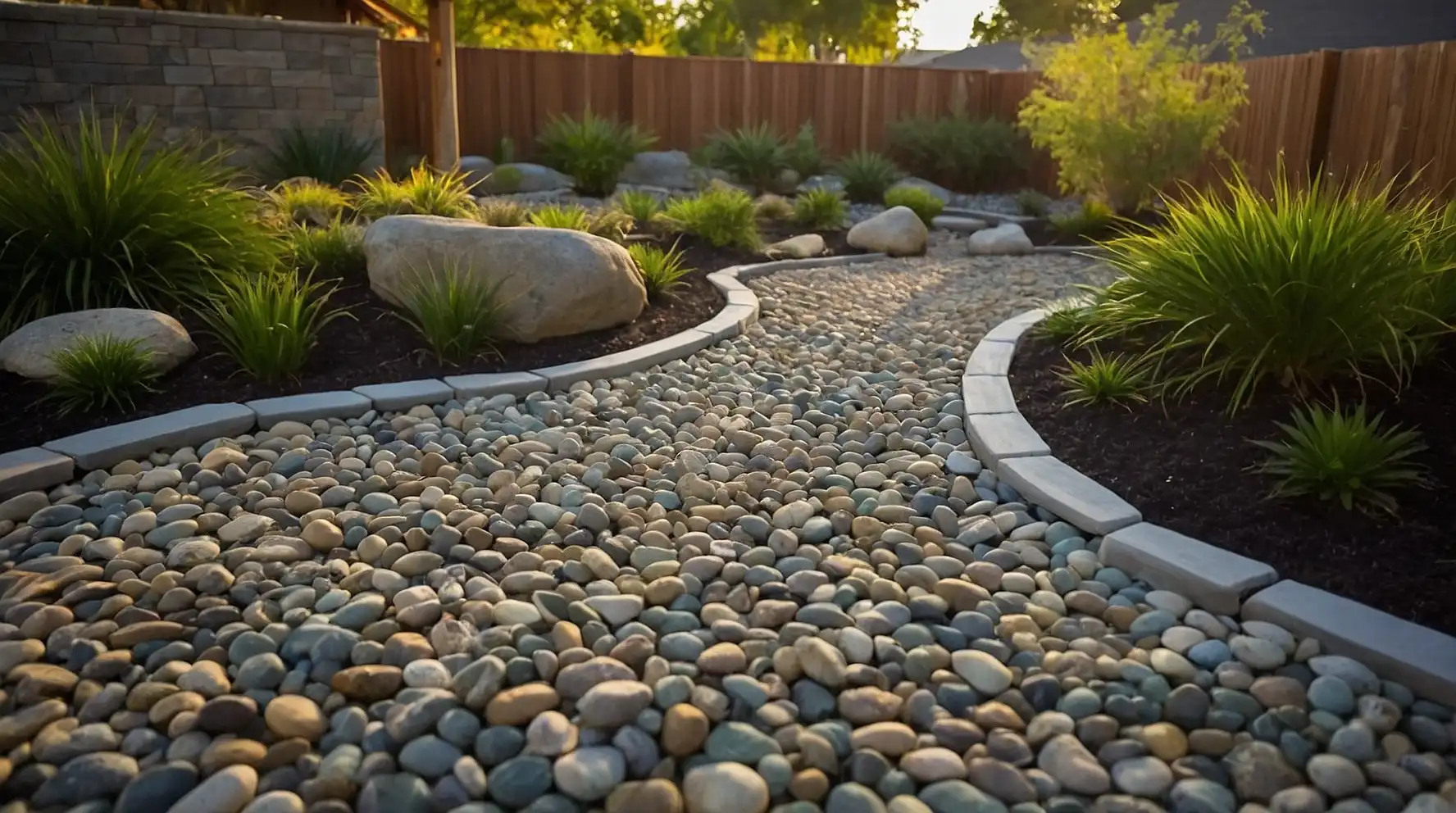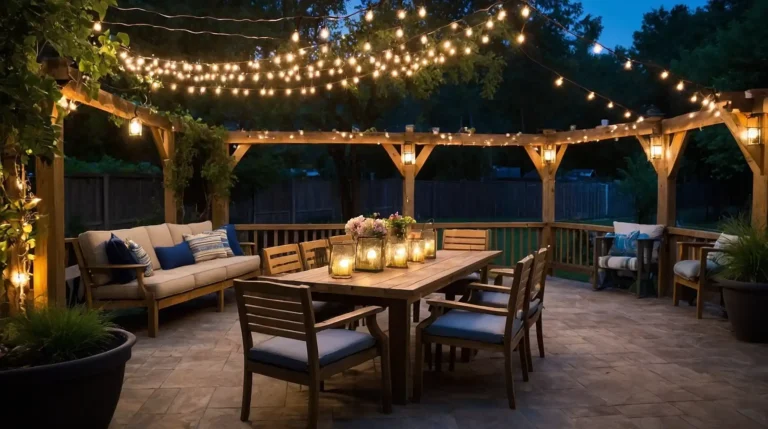25 Beautiful River Rock Landscaping Ideas to Transform Your Outdoor Space
River rocks bring natural elegance to any landscape design with their smooth textures and varied colors.
These versatile stones create low-maintenance solutions for challenging areas while adding visual interest and natural beauty.
Unlike mulch or gravel that requires frequent replacement, river rock provides a long-lasting foundation for your outdoor spaces.
The rounded stones complement both modern and traditional design aesthetics.
With thoughtful placement and creative combinations with other elements, river rocks can solve drainage issues, define spaces, and create stunning focal points.
Discover these 25 inspiring ideas to incorporate river rocks into your landscape design.
1: Dry Creek Bed

Create a realistic-looking dry creek bed using variegated river rocks to mimic a natural waterway.
Position larger stones along the edges and smaller pebbles in the center for authentic movement.
Shape the bed with gentle curves rather than straight lines.
This design feature doubles as functional drainage during heavy rainfall while adding visual interest year-round.
Plant moisture-loving perennials along the edges to complete the natural stream appearance.
2: Japanese-Inspired Rock Garden

Design a tranquil Japanese-inspired garden using carefully arranged river rocks of varying sizes. Create a minimalist landscape that evokes calm and contemplation.
Include larger feature stones as focal points among the smoother river rocks.
Add architectural plants like Japanese maples, dwarf conifers, or ornamental grasses for contrast.
Incorporate a simple wooden bridge or traditional lantern to complete the peaceful aesthetic.
3: River Rock Pathway

Construct a welcoming pathway using flat river stones set in sand or decomposed granite.
Select stones with relatively flat surfaces for comfortable walking while maintaining natural appearance.
Position stones close enough for easy stepping but with small gaps to allow groundcover plants to grow between them.
The irregular shapes create a more organic, meandering feel than formal pavers.
This durable solution works beautifully for garden access paths and side yards.
4: Water Feature Surround

Edge a pond or water feature with river rocks to create a natural transition between water and landscape.
Arrange stones in graduated sizes with larger rocks closest to the water.
Partially submerge some stones along the waterline for a weathered look. The smooth stones prevent soil erosion while hiding pond liners or container edges.
This technique enhances the natural appearance of any water feature while providing practical edge protection.
5: Tree Ring Mulch Alternative

Surround trees with circular river rock beds instead of traditional mulch.
The stones provide protection from lawn equipment while allowing water to penetrate to roots.
Choose smaller stones (1-2 inches) for a refined appearance. Create a defined edge using metal, plastic, or stone borders to prevent migration into the lawn.
This long-lasting alternative to wood mulch won’t decompose or need annual replacement.
6: Succulent Rock Garden

Combine drought-tolerant succulents with river rocks to create a water-wise garden feature.
The stones provide perfect drainage for succulent roots while adding textural contrast.
Nestle small succulents between and around larger stones for a natural appearance.
Choose rock colors that complement your succulent palette—grays with blue-green plants or warm tones with red varieties.
This low-maintenance combination thrives in hot, dry areas while providing year-round visual interest.
7: Rain Garden Basin

Construct a functional rain garden using river rocks as the foundation for managing storm water runoff.
Create a shallow depression lined with graduated stones that filter water naturally.
Position larger rocks at drainage entry points to slow water flow and prevent erosion.
Add water-tolerant native plants between stones to enhance filtration and aesthetics.
This eco-friendly solution beautifully addresses drainage issues while supporting local wildlife.
8: Raised Bed Edging

Edge raised garden beds with stacked river rocks to create natural-looking borders.
Choose relatively flat stones that stack securely without mortar for a dry-stacked appearance.
Vary stone sizes and colors for organic visual interest. The weight and stability of the rocks create durable boundaries that won’t rot like wood alternatives.
This practical approach adds textural contrast to the soft lines of plants while clearly defining growing spaces.
9: Fire Pit Surround

Create a safety barrier around your fire pit using a ring of larger river rocks.
The stones provide heat resistance while enhancing the natural, rustic appeal of your outdoor gathering space.
Choose stones at least 6-8 inches in diameter for stability and safety.
Consider incorporating flat-topped rocks at intervals for occasional seating or as places to rest drinks.
This functional design element transitions your fire feature beautifully into the surrounding landscape.
10: Rock Mulch for Problem Areas

Replace traditional mulch with river rock in challenging areas where organic materials wash away.
Shady, sloped sections particularly benefit from this stable alternative.
Use landscape fabric underneath to suppress weeds before adding a 2-3 inch layer of small to medium stones.
The permanent nature of stone prevents annual replacement challenges.
This practical solution works especially well in narrow side yards and under eaves where plants struggle.
11: Terraced Hillside Stabilization
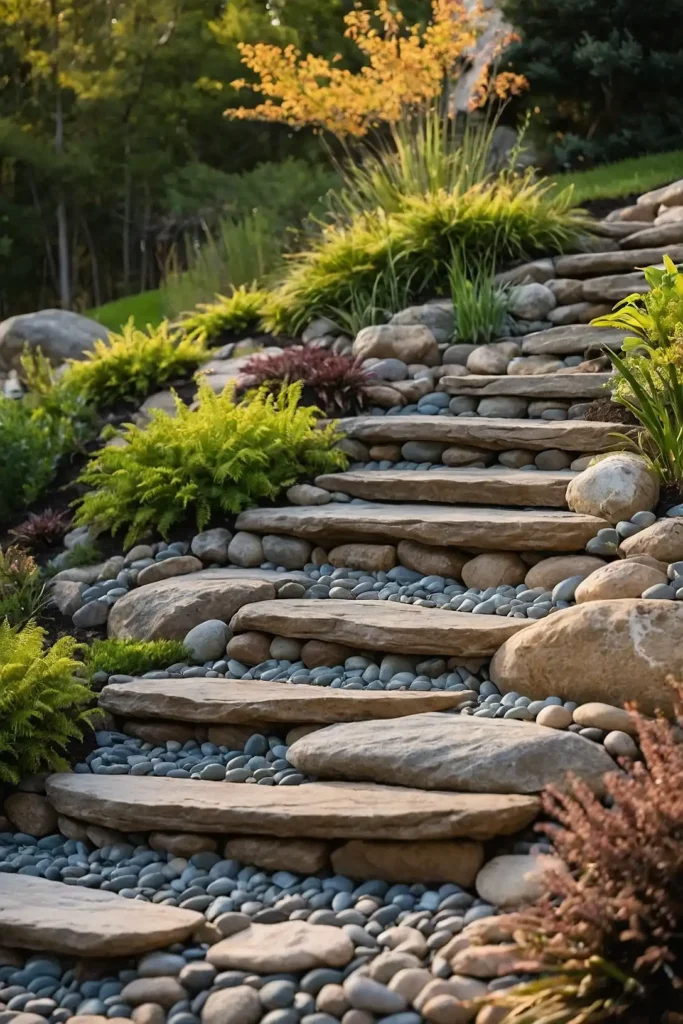
Control erosion on sloped properties by creating terraced levels reinforced with river rocks.
Build low retaining walls with larger stones and fill the flat areas with smaller river rock for drainage.
Add strategic plantings between terraces to further stabilize soil with root systems.
This combination of hard and soft elements creates visual interest while solving challenging terrain issues.
The porous nature of the stone arrangement allows proper water management while preventing soil loss.
12: Meditation Spiral
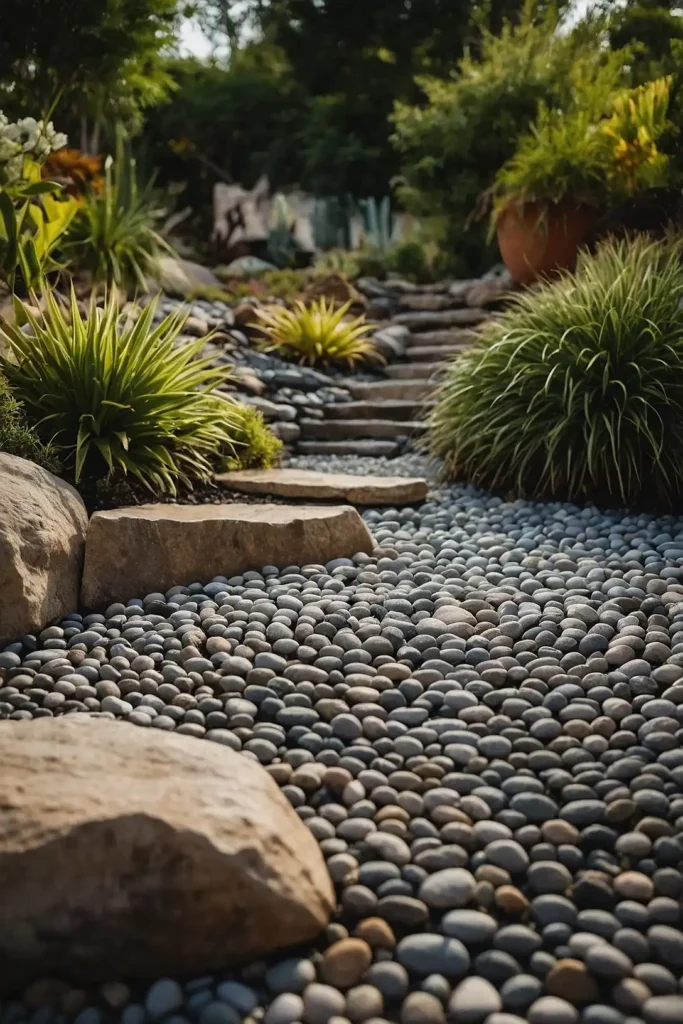
Create a walking meditation spiral using river rocks as path markers. Arrange stones in a spiral pattern large enough to walk through comfortably.
Use consistent-sized rocks to define the edges clearly. Plant aromatic herbs or low groundcovers between the stones to release scent as you walk.
This meaningful landscape feature provides both visual interest and a space for mindful contemplation.
13: Decorative Dry River Moat

Surround your home’s foundation with a decorative river rock moat that improves drainage while adding architectural interest.
This practical feature prevents splash-back onto siding during rainfall.
Include slightly larger stones near downspouts to disperse water flow. Plant occasional ornamental grasses or perennials for softness against the hardscape.
This functional design element creates a polished transition between building and landscape while managing moisture effectively.
14: Gabion Rock Wall

Construct modern-looking retaining walls using wire gabion baskets filled with river rocks.
These permeable structures provide excellent drainage while creating dramatic visual texture.
Choose consistently sized stones for a more uniform appearance or mix sizes for natural variety.
The metal cages can form straight walls or gentle curves depending on your landscape needs.
This contemporary approach combines industrial and natural elements for striking landscape architecture.
15: Rock Mulch Plant Islands

Create defined planting islands surrounded by fields of river rock for a drought-tolerant landscape approach.
Design organic-shaped islands with sufficient soil volume for plant groups.
Select plants with complementary textures and colors to contrast with the stone.
The rock “sea” around plantings reduces overall water requirements while eliminating most mowing needs.
This low-maintenance design works beautifully in arid climates or areas with watering restrictions.
16: Rock Spillway

Direct water movement through your landscape with a constructed river rock spillway between elevation changes.
Arrange stones to create a natural-looking waterfall effect, even when dry.
Secure larger anchor stones at top and bottom for stability.
During rainfall, water will follow your designed path, preventing erosion while creating dramatic movement.
This functional feature becomes even more beautiful during and after rain events.
17: Container Garden Topdressing
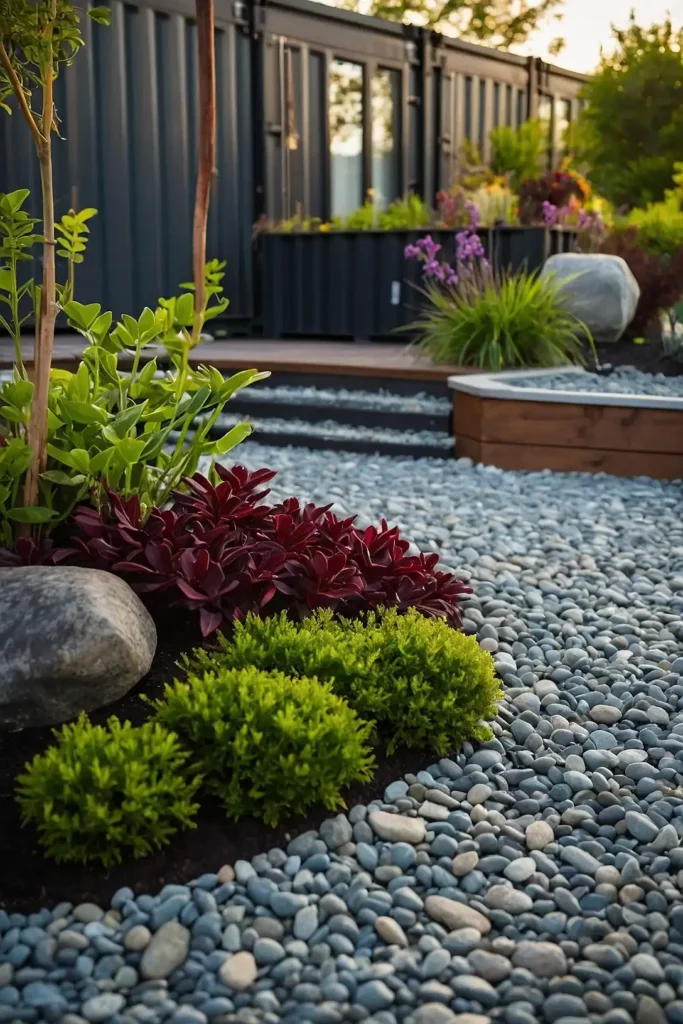
Add a layer of small, polished river stones as topdressing for container plants.
This decorative finish covers soil while reducing moisture evaporation and preventing splashing during watering.
Choose stone colors that complement your container and plant selections. The weight also provides stability for top-heavy plantings in windy locations.
This simple technique instantly elevates container presentations with minimal effort and expense.
18: Pebble Mosaic
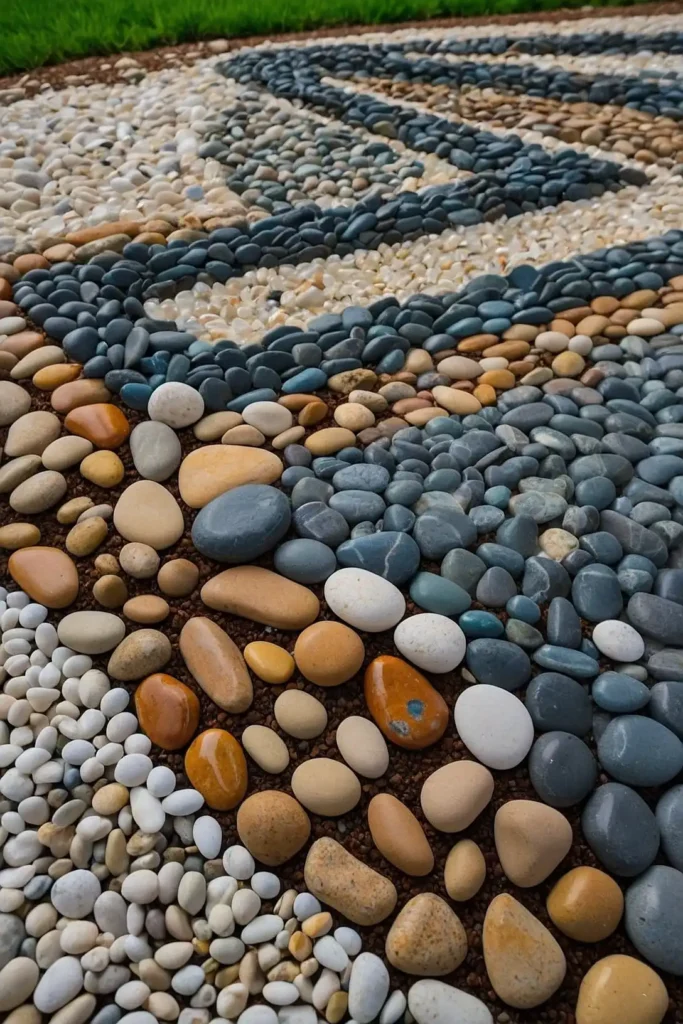
Create artistic patterns or simple designs using different colored river pebbles set in concrete.
Design geometric shapes, spirals, or pictorial elements for walkways or patio inserts.
Sort stones by size and color before beginning your installation.
Set in mortar for permanent installation or use polymeric sand for semi-permanent designs that can be changed.
This decorative technique transforms ordinary paving into personalized landscape art.
19: Riverstone Focal Wall

Build a dramatic garden wall using flat river rocks stacked without mortar as a backdrop for plantings.
Create a dry-stacked appearance with carefully selected stones that fit together securely.
Limit height to 2-3 feet for stability without footings. Include small soil pockets for cascading plants or succulents to soften the stone surface.
This architectural element adds vertical interest to garden spaces while providing habitat opportunities for beneficial insects.
20: River Rock Swale

Manage water runoff with a shallow, stone-lined drainage swale that moves water across your property.
Line the depression with graded river rocks, larger in the center and smaller at the edges.
Design gentle curves that follow your land’s natural contours. Incorporate water-loving plants along the edges that can tolerate both wet and dry conditions.
This eco-friendly drainage solution becomes an attractive landscape feature rather than an eyesore.
21: Woodland Garden Floor

Create a natural-looking woodland garden floor using river rocks as groundcover beneath shade trees.
Mimic forest stream beds with organically shaped stone arrangements among ferns and woodland plants.
Use varying stone sizes from pea gravel to hand-sized rocks for realistic appearance.
Allow moss to develop naturally on stones in damp areas for enhanced woodland character.
This low-maintenance approach eliminates mowing in difficult shady areas while creating magical forest ambiance.
22: Rock-Lined Steps
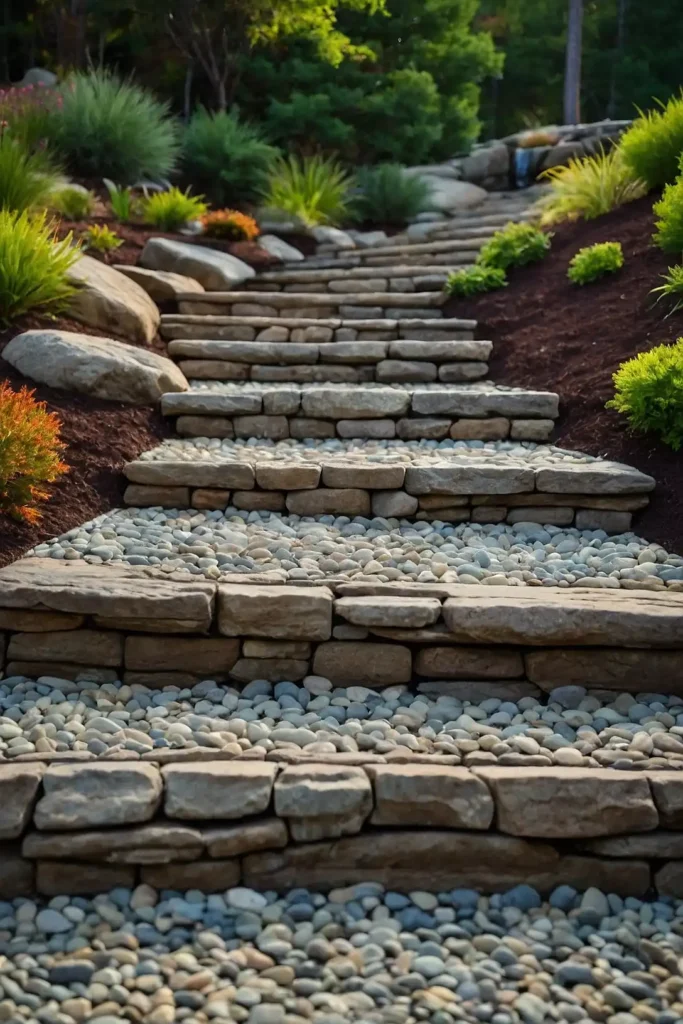
Build natural-looking garden steps using larger flat river rocks as treads with smaller stones filling between them.
This method creates secure footing while maintaining an organic appearance.
Use landscape construction adhesive to secure the main stepping stones.
Fill around with smaller river pebbles to prevent shifting and provide drainage.
This approach works beautifully on gentle slopes where formal stairs would look too structured.
23: Zen Garden Rake Patterns

Create a contemplative space with a small river rock garden designed for meditative raking. Use fine, consistently sized pebbles confined within a simple border.
Include a few carefully positioned larger stones as focal points among the smaller pebbles. Provide a special rake for creating patterns that you can change regularly.
This mindful garden feature offers both visual appeal and stress-reducing activity.
24: Rock Reed Bed

Construct a naturalistic filtration system for greywater using river rocks and water-purifying plants.
Create a graduated basin filled with various stone sizes and appropriate wetland plants.
Direct water through the system to be naturally filtered by rock layers and plant roots.
This functional feature recycles household water while creating habitat for wildlife.
The combination of stones, water movement, and verdant plants creates a beautiful landscape feature with ecological benefits.
25: Stone Stream Table

Design an interactive water feature using river rocks that allows children to create miniature waterways.
Build a raised table structure with edges and a slight slope for water flow.
Include various sizes of smooth river stones for designing different stream arrangements.
Add a small recirculating pump system with reservoir for endless water play.
This engaging landscape element provides educational opportunities about water dynamics while offering sensory-rich outdoor activity.
Conclusion
Start with one river rock project that addresses your most pressing landscape need.
Once comfortable with the material, expand to more creative applications.
Remember that proper preparation with landscape fabric and edging ensures your river rock features remain low-maintenance for years.

